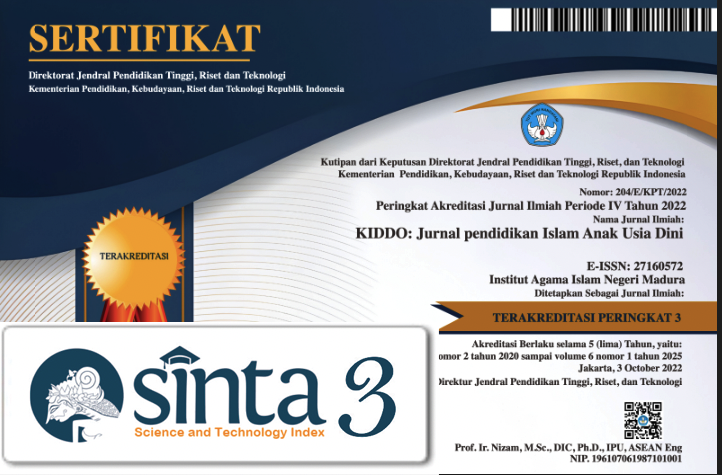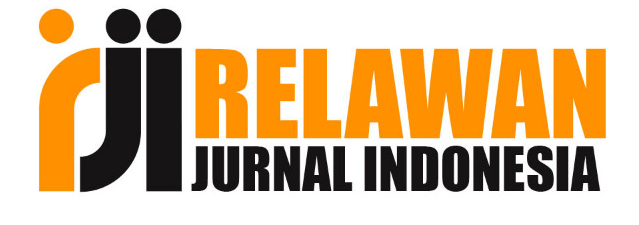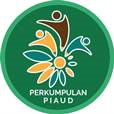Transformasi Pembelajaran Motorik Kasar melalui Sintesis Demonstrasi Gerak-Lagu dan Model ATIK: Studi di TK Pertiwi Saleppa
 Abstract views: 45
,
Abstract views: 45
,
 PDF downloads: 31
PDF downloads: 31
Abstract
The development of gross motor skills serves as a key aspect in early childhood education. This study aims to analyze the transformation of gross motor learning through the synthesis of movement-song demonstration and ATIK model at TK Pertiwi Saleppa. This qualitative research employs a case study design involving 20 group B students (5 males, 15 females) and their teachers as research subjects. Data collection utilizes participatory observation, in-depth interviews, and documentation. Research findings reveal three major improvements: First, teaching practices become more structured through systematic planning, interactive delivery, and comprehensive assessment. Second, student engagement increases, shown by enhanced cognitive involvement during observation and imitation phases, optimal physical participation during improvisation and creation stages, and growing social interaction throughout learning activities. Third, gross motor skills develop progressively, evidenced by improved movement coordination, better balance control, and expanded movement creativity. The synthesis of movement-song demonstration and ATIK model creates an effective framework for gross motor development while maintaining student engagement throughout the learning process.
Downloads
References
Aloizou, V., Linardatou, S., Boloudakis, M., & Retalis, S. (2025). Integrating a movement‐based learning platform as core curriculum tool in kindergarten classrooms. British Journal of Educational Technology, 56(1), 339–365. https://doi.org/10.1111/bjet.13511
Ansari, J. A. N., & Khan, N. A. (2020). Exploring the role of social media in collaborative learning the new domain of learning. Smart Learning Environments, 7(1), 9. https://doi.org/10.1186/s40561-020-00118-7
Badriyah, A. U., Ristyadewi, F., & Fitria, N. (2020). Gross Motor Ability in Early Childhood Through Motion and Song Activities. Proceedings of the 4th International Conference on Learning Innovation and Quality Education, 1–4. https://doi.org/10.1145/3452144.3452169
Bhoyroo, R., Hands, B., Caeyenberghs, K., De Luca, A., Leemans, A., Wigley, A., & Hyde, C. (2022). Association between Motor Planning and the Frontoparietal Network in Children: An Exploratory Multimodal Study. Journal of the International Neuropsychological Society, 28(9), 926–936. https://doi.org/10.1017/S1355617721001168
Boat, R., Cooper, S. B., Carlevaro, F., Magno, F., Bardaglio, G., Musella, G., & Magistro, D. (2022). 16 Weeks of Physically Active Mathematics and English Language Lessons Improves Cognitive Function and Gross Motor Skills in Children Aged 8–9 Years. International Journal of Environmental Research and Public Health, 19(24), 16751. https://doi.org/10.3390/ijerph192416751
Brian, A., Munn, E. E., Abrams, T. C., Case, L., Taunton Miedema, S., Stribing, A., Lee, U., & Griffin, S. (2024). SKIPping With PAX: Evaluating the Effects of a Dual-Component Intervention on Gross Motor Skill and Social–Emotional Development. Journal of Motor Learning and Development, 12(1), 228–246. https://doi.org/10.1123/jmld.2023-0034
Brown, K. K., Smith, J., Bailey, T. N., Ortiz, G., Gu, X., & Tamplain, P. (2022). Parent-Reported Motivators and Barriers to Participation in a Community-Based Intervention Designed for Children With Motor Skill Difficulties: A Qualitative Program Evaluation. Adapted Physical Activity Quarterly, 39(1), 109–128. https://doi.org/10.1123/apaq.2020-0142
Creswell, J. W. (2014). Research Design: Qualitative, Quantitative, and Mixed Methods Approaches (4 th). SAGE Publications.
Dewi, M. S. & Yufiarti. (2021). Play-based Learning Activities for Creativity in Children’s Dance Movements. JPUD - Jurnal Pendidikan Usia Dini, 15(1), 101–120. https://doi.org/10.21009/JPUD.151.06
Díaz-Pérez, A., Vicente-Nicolás, G., & Valero-García, A. V. (2021). Music, Body Movement, and Dance Intervention Program for Children with Developmental Coordination Disorder. Psychology of Music, 49(5), 1215–1225. https://doi.org/10.1177/0305735620936353
Esen, H. T., Güçlüöver, A., Kurnaz, M., & Altinkök, M. (2023). The Impact of Coordination-Based Movement Education Model on Balance Development of 5-Year-Old Children. Frontiers in Psychology, 13, 1045155. https://doi.org/10.3389/fpsyg.2022.1045155
Fajariani, K. (2024). Literature Review on the Implementation of Integrated Learning in Bireuen 4 Primary School. Journal Informatic, Education and Management (JIEM), 6(2), 70–73. https://doi.org/10.61992/jiem.v6i2.105
Fitrianto, A. T., Habibie, M., & Prayoga, H. D. (2023). Teaching Games For Understanding (TGFU) Developing Gross Motor Skill in Physical Education. Journal of Physical and Outdoor Education, 5(2), 24–31. https://doi.org/10.37742/jpoe.v5i2.226
Gandotra, A., Kotyuk, E., Bizonics, R., Khan, I., Petánszki, M., Kiss, L., Paulina, L., & Cserjesi, R. (2023). An Exploratory Study of The Relationship Between Motor Skills And Indicators of Cognitive and Socio-Emotional Development in Preschoolers. European Journal of Developmental Psychology, 20(1), 50–65. https://doi.org/10.1080/17405629.2022.2028617
Gastelum-Acosta, P. E., Acosta López, D. R., Ramírez Torres, G. I., Chávez Erives, A. I., & Gastélum-Cuadras, G. (2024). Socio-Educational Strategies Plan for The Development of Psychomotor Skills in Early Childhood Edu-Cation Students. Retos, 55, 745–755. https://doi.org/10.47197/retos.v55.97257
Gencigör, M. C., & Akın, S. (2024). Developing Children’s Motor Skills by Having Fun With Orff’s Approach. Perceptual and Motor Skills, 131(5), 1517–1530. https://doi.org/10.1177/00315125241272497
Greco, A. (2021). Spatial and Motor Aspects in the “Action-Sentence Compatibility Effect.” Frontiers in Psychology, 12, 647899. https://doi.org/10.3389/fpsyg.2021.647899
Gumono, G., Sarwono, S., Yulistio, D., Pitawan, K. A., Solihin, M., & Julianto, E. (2022). Development of Local Wisdom-Based Thematic Teaching Materials to Improve Adaptive Cultural Literacy. Community Empowerment, 7(6), 978–987. https://doi.org/10.31603/ce.6560
Hadar, L. L., Baharav, H., & Cohen, E. (2024). Situated Partnership: Dynamics of Role Formation in a Research–Practice Partnership. Teachers College Record: The Voice of Scholarship in Education, 126(4–5), 88–113. https://doi.org/10.1177/01614681241266396
Han, Y., Chen, Z., Williams, K. A., & Ravichandar, H. (2024). Learning Prehensile Dexterity by Imitating and Emulating State-Only Observations. IEEE Robotics and Automation Letters, 9(10), 8266–8273. https://doi.org/10.1109/LRA.2024.3443595
Hanifah, S. & Euis Kurniati. (2024). Eksplorasi Peran Lingkungan dalam Masa Transisi Pendidikan Anak Usia Dini ke Sekolah Dasar: Peran Lingkungan dalam Masa Transisi PAUD ke SD. Kiddo: Jurnal Pendidikan Islam Anak Usia Dini, 5(1), 130–142. https://doi.org/10.19105/kiddo.v5i1.11576
Iskandar, S., Rosmana, P. S., Laksita, E. C., Sari, T. F. P., & Laila, W. N. (2024). Implementation of Integrated Learning to Enhance Elementary School Students’ Creativity. Journal of Pedagogi, 1(3), 14–19. https://doi.org/10.62872/jkvpqp43
Keller, M., Roth, R., Achermann, S., & Faude, O. (2023). Learning a new balance task: The influence of prior motor practice on training adaptations. European Journal of Sport Science, 23(5), 809–817. https://doi.org/10.1080/17461391.2022.2053751
Lavarda, R., & Bellucci, C. (2022). Case Study as a Suitable Method to Research Strategy as Practice Perspective. The Qualitative Report. https://doi.org/10.46743/2160-3715/2022.4296
Lengkana, A. S., Saptani, E., Sudirjo, E., Rosalina, M., Hermawan, D. B., & Sugiarto, B. G. (2022). Movement Coordination Learning Model: Basic Motoric Skill For Elementary Students. JUARA : Jurnal Olahraga, 7(3), 683–691. https://doi.org/10.33222/juara.v7i3.2048
Loh, A., Bourke, M., Saravanamuttoo, K., Bruijns, B. A., & Tucker, P. (2024). The Impact of An Early Childhood Educator E-Learning Courseo on Young Children’s Fundamental Movement Skills: A Cluster Randomized Controlled Trial. Journal of Sports Sciences, 42(17), 1635–1643. https://doi.org/10.1080/02640414.2024.2404777
Maceira-Elvira, P., Timmermann, J. E., Popa, T., Schmid, A.-C., Krakauer, J. W., Morishita, T., Wessel, M. J., & Hummel, F. C. (2022). Dissecting Motor Skill Acquisition: Spatial Coordinates Take Precedence. Science Advances, 8(29), eabo3505. https://doi.org/10.1126/sciadv.abo3505
Marconi, G. R., Losif, I., Brigitte, O., Csongor, T., Dulceanu, C. R., & Gyongyi, O. (2024). The Study Of Types Of Speed Through Team Games. Arena - Journal of Physical Activities, 12, 137–150. https://doi.org/10.62591/ajpa.2023.12.10
Marinšek, M., & Denac, O. (2020). The Effects of an Integrated Programme on Developing Fundamental Movement Skills and Rhythmic Abilities in Early Childhood. Early Childhood Education Journal, 48(6), 751–758. https://doi.org/10.1007/s10643-020-01042-8
Moleong, L. J. (2015). Metodelogi Penelitian Kualitatif: Edisi Revisi. Remaja Rosdakarya.
Momčilović, V., & Zdravković, V. (2020). The Influence of Integration of Physical and Music Education on Class Teaching Students Motor Skills Development. Facta Universitatis, Series: Teaching, Learning and Teacher Education, 4(1), 25–45. https://doi.org/10.22190/FUTLTE2001035M
Neto, J. C., Lima, A. de O., & Costa, E. C. (2024). Qualitative Nursing Research: Evidence of Scientific Validation From a Translational Perspective. Investigación y Educación en Enfermería, 42(1). https://doi.org/10.17533/udea.iee.v42n1e11
Nielsen-Rodríguez, A., Romance, R., Dobado-Castañeda, J. C., & Gil-Espinosa, F. J. (2022). Evaluation of a Proposal for Movement Integration in the Teaching–Learning Process in Early Childhood Education. Children, 9(2), 231. https://doi.org/10.3390/children9020231
Østerlie, O., Sargent, J., Killian, C., Garcia-Jaen, M., García-Martínez, S., & Ferriz-Valero, A. (2023). Flipped Learning in Physical Education: A Scoping Review. European Physical Education Review, 29(1), 125–144. https://doi.org/10.1177/1356336X221120939
Purwanto, D., Rejeki, H. S., & Mentara, H. (2024). Game-Based Physical Learning Model to Enhance Gross Motor Skills in Young Students. Jurnal SPORTIF : Jurnal Penelitian Pembelajaran, 10(3), 503–520. https://doi.org/10.29407/js_unpgri.v10i3.23982
Rafifah, F. A., Anissa, F., Muklis, F. A., & Putri, S. U. (2023). Learning Strategies in PAUD to Stimulate Early Childhood Gross Motor Development. Feelings: Journal of Counseling and Psychology, 1(1), 34–43. https://doi.org/10.61166/feelings.v1i1.4
Riddel, M., & Zulfikar, I. R. (2024). The Role of Innovative Leadership in Transforming Student Learning Effectiveness: A Review of Best Practices and Future Directions. Development: Studies in Educational Management and Leadership, 3(1), 35–50. https://doi.org/10.47766/development.v3i1.1913
Roque, A., Wutich, A., Brewis, A., Beresford, M., Landes, L., Morales-Pate, O., Lucero, R., Jepson, W., Tsai, Y., Hanemann, M., & Water Equity Consortium, A. F. (2024). Community-based Participant-observation (CBPO): A Participatory Method for Ethnographic Research. Field Methods, 36(1), 80–90. https://doi.org/10.1177/1525822X231198989
Sando, O. J., Sandseter, E. B. H., & Brussoni, M. (2023). The Role of Play and Objects in Children’s Deep-Level Learning in Early Childhood Education. Education Sciences, 13(7), 701. https://doi.org/10.3390/educsci13070701
Simaremare, T. P., Sri Indriani Harianja, Felisa Mutia Zahra, Friska Septiardilla, Muhammad Rohimin, & Wahyu Nur Sofyan. (2024). Penerapan Pembelajaran Kreatif dalam Pelaksanaan Pendidikan Nonformal Bagi Anak Usia Dini di Suku Anak Dalam Desa Sekaladi. Kiddo: Jurnal Pendidikan Islam Anak Usia Dini, 5(1), 1–16. https://doi.org/10.19105/kiddo.v5i1.11351
Siregar, E. S., Imanuddin, & Sari, I. P. (2023). Development of Audio-Visual Media on the Physical Motor Development of Students in Big Kindergarten. JTP - Jurnal Teknologi Pendidikan, 25(3), 363–370. https://doi.org/10.21009/jtp.v25i3.36947
Sollerhed, A.-C. (2023). Teaching Movement and Physical Activity in Early Childhood Education and Care, An Obvious and Important Objective, or A Challenging and Provocative Task for Educators? European Journal of Public Health, 33(Supplement_1), ckad133.188. https://doi.org/10.1093/eurpub/ckad133.188
Stevenson, A., Wainwright, N., & Williams, A. (2023). Interventions targeting motor skills in pre-school-aged children with direct or indirect parent engagement: A systematic review and narrative synthesis. Education 3-13, 51(6), 1003–1016. https://doi.org/10.1080/03004279.2022.2034174
Subagia, N. K. T. F., Suryaningsih, N. M. A., & Prima, E. (2024). Gerak dan Lagu Sebagai Upaya untuk Meningkatkan Kreativitas Gerak Anak Usia Dini. Incrementapedia : Jurnal Pendidikan Anak Usia Dini, 6(1), 44–52. https://doi.org/10.36456/incrementapedia.vol6.no1.a8703
Sungeelee, V., Loriette, A., Sigaud, O., & Caramiaux, B. (2024). Interactive Curriculum Learning Increases and Homogenizes Motor Smoothness. Scientific Reports, 14(1), 2843. https://doi.org/10.1038/s41598-024-53253-3
Waffak, M. N., Arifianti, E., & Agustiningsih, R. (2024). Development of an Outdoor Play-Based Learning Model to Train Gross Motor Skills in Early Childhood. Kinestetik : Jurnal Ilmiah Pendidikan Jasmani, 8(2), 275–281. https://doi.org/10.33369/jk.v8i2.34338
Copyright (c) 2025 St. Maria Ulfah

This work is licensed under a Creative Commons Attribution 4.0 International License.
-
The journal operates an Open Access policy under a Creative Commons 4.0 International license. The terms of the license are:
Share— copy and redistribute the material in any medium or format
Adapt— remix, transform, and build upon the material for any purpose, even commercially.
1. Authors retain copyright and grant the journal right of first publication with the work simultaneously licensed under a Creative Commons License.that allows others to share the work with an acknowledgement of the work’s authorship and initial publication in this journal
2. Authors are permitted and encouraged to post their work online (e.g., in institutional repositories or on their website) prior to and during the submission process, as it can lead to productive exchanges, as well as earlier and greater citation of published work (See The Effect of Open Access).
Jurnal Kiddo is licensed under a Creative Commons
n Access).














